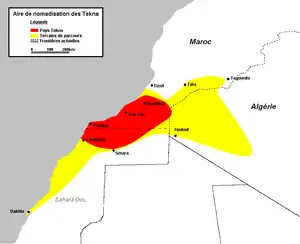Tekna
The Tekna is a semi-nomadic[2] Sahrawi tribal confederation of Lamta Sanhaja Berber origins.[2][3][4] Its constituents today inhabit southern Morocco and northern Western Sahara, but traditionally with wider migration routes. Nowadays, its population is estimated to be around 709,000.[1]
 The Tekna country (red) and migration routes (yellow) | |
| Total population | |
|---|---|
| 709,000[1] | |
| Regions with significant populations | |
| Morocco - Guelmim and Tarfaya areas Western Sahara - Saguia el-Hamra | |
| Languages | |
| Hassaniya, Shilha | |
| Religion | |
| Islam (Sunni) | |
| Related ethnic groups | |
| Berbers |
Demographics
The Tekna tribes speak Hassaniya Arabic and the Berber Shilha dialect in varying degrees.[5]
All Tekna are Muslims, belonging to the Maliki school of Sunni Islam. Their traditional lifestyle was partly nomadic, based on camel and goat herding, and partly sedentary, controlling important routes of the Saharan caravan trade.
The Tekna are divided into several Berber-speaking and Arabic-speaking tribes, which are organized into two tribal confederations or leff:[6]
- Aït Djemel confederacy (Western Tekna), consisting of the tribes of Aït Lahcen, Izerguiyen, Yaggout, and Aït Moussa Ou Ali ;
- Aït Atman (or Aït Bella) confederacy (Eastern Tekna), consisting of the tribes of Azouafit, Aït Yassine, Aït Oussa, Aït Brahim, and Aït Hmad.
History
During the 17th century, Morocco under Sultan Ismail Ibn Sharif seized control over the territory from the Tafna River south to Senegal and Timbuktu. Contingents of Tekna troops were then sent to the Senegal valley on behalf of the Sultan.[7]
After 1765 the Tekna revolted, acquiring greater autonomy.[8] On May 30, 1767, Mohammed ben Abdallah, Sultan of Morocco, signed a peace and commerce treaty with King Charles III of Spain, recognizing that Morocco did not control the Tekna tribes.[9]
However, at the time of the Spanish colonization and at the beginning of the 20th century, the Tekna tribes recognized the Sultan of Morocco as their sultan.[10][11]
See also
References
- Project, Joshua. "Berber, Tekna :: Joshua Project". joshuaproject.net. Retrieved 2016-07-21.
- Gaudio, Attilio (1993-01-01). Les populations du Sahara occidental: histoire, vie et culture (in French). KARTHALA Editions. ISBN 9782865374113.
- Castellino, Joshua (2000). International Law and Self-Determination. The Hague: Martinus Nijhoof publishers. pp. 239–243. ISBN 90-411-1409-2.
- Barbier, Maurice (2003-06-01). Le conflit du Sahara occidental: Réédition d'un livre paru en 1982 (in French). Editions L'Harmattan. ISBN 9782296278776.
- Claire Cécile Mitatre, « Le couloir ouest-saharien : un espace gradué », L’Année du Maghreb, VII (2011), p.211-228
- "Archived copy" (PDF). Archived from the original (PDF) on 2014-05-30. Retrieved 2014-05-29.CS1 maint: archived copy as title (link)
- Attilo Gaudio (1993), Les populations du Sahara occidental: histoire, vie et culture, p.106
- Attilo Gaudio (1993), Les populations du Sahara occidental: histoire, vie et culture, p.107
- Pedro Giménez de Aragón Sierra. "Proyecto Ibn Jaldun. VII. El colonialismo español en el s. XIX: África. 2. Chafarinas, Sidi Ifni y el Sáhara" (in Spanish). Junta de Andalucía. Retrieved 2010-06-15.
- Histoire et géographie de l'Europe. Tekna Confederation (Tekna). Depends upon Morocco
- International Court of Justice. Advisory Opinion of 16 October 1975
Bibliography
(in French) Attilo Gaudio, "Les populations du Sahara occidental: histoire, vie et culture", ed. Karthala 1993, (Chap. VIII, pp. 97–116) (ISBN 2-86537-411-4)